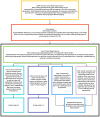JU:MP leads: sparking physical activity leadership and supporting positive youth development in a deprived community
- PMID: 39749263
- PMCID: PMC11693495
- DOI: 10.3389/fspor.2024.1490688
JU:MP leads: sparking physical activity leadership and supporting positive youth development in a deprived community
Abstract
Introduction: Physical activity interventions in deprived communities should acknowledge the social, political, and cultural context in which they are delivered. Targeted young leaders programs can harness positive youth development principles and address these concerns by engaging underrepresented young people and developing them as physical activity leaders who can support local delivery efforts. Community-based Youth Leadership development programs are under-researched, and little is known about how to develop young people from deprived communities as physical activity leaders.
Methods: This research project used interviews, focus groups and Ripple Effects Mapping to evaluate a community based young physical activity leaders development program delivered in a community with high levels of deprivation in Bradford, UK.
Results: The program, known as "JU:MP leads" developed 20 young people aged 16-25 as young leaders between September 2022 and September 2023. Thematic analysis of data uncovered that a community-based young leaders development program can be effective in supporting local young people from a deprived community to develop as physical activity leaders, particularly when adopting a flexible delivery model through which young people can engage around other commitments. Key mechanisms within the program that supported development included the acquisition of formal, nationally recognised qualifications, informal training and mentorship, peer support and ongoing reflection. These key mechanisms of the program facilitated the personal and professional development of the young people into confident and assured physical activity leaders.
Discussion: The research concluded that community based physical activity leaders programs can support Positive Youth Development of young people from deprived communities by developing their skills and supporting them to make valid contributions to local physical activity provision.
Keywords: community; deprived community; physical activity; positive youth development; young leaders.
© 2024 Crowther, Lever, Dogra, Barber and Hall.
Conflict of interest statement
The authors declare that the research was conducted in the absence of any commercial or financial relationships that could be construed as a potential conflict of interest.
Figures
Similar articles
-
Activating the 'peerness' of youth leaders in a community sports programme through techne and phronesis.Health Promot Int. 2022 Dec 1;37(6):daac141. doi: 10.1093/heapro/daac141. Health Promot Int. 2022. PMID: 36300702
-
Girls Just Wanna Have Fun: a process evaluation of a female youth-driven physical activity-based life skills program.Springerplus. 2014 Aug 3;3:401. doi: 10.1186/2193-1801-3-401. eCollection 2014. Springerplus. 2014. PMID: 25143873 Free PMC article.
-
Developing palliative care programs in Indigenous communities using participatory action research: a Canadian application of the public health approach to palliative care.Ann Palliat Med. 2018 Apr;7(Suppl 2):S52-S72. doi: 10.21037/apm.2018.03.06. Ann Palliat Med. 2018. PMID: 29764173
-
Impact of summer programmes on the outcomes of disadvantaged or 'at risk' young people: A systematic review.Campbell Syst Rev. 2024 Jun 13;20(2):e1406. doi: 10.1002/cl2.1406. eCollection 2024 Jun. Campbell Syst Rev. 2024. PMID: 38873396 Free PMC article. Review.
-
Peer support for people with chronic conditions in rural areas: a scoping review.Rural Remote Health. 2016 Jan-Mar;16(1):3601. Epub 2016 Mar 5. Rural Remote Health. 2016. PMID: 26943760
References
-
- Bingham DD, Daly-Smith A, Hall J, Seims A, Dogra SA, Fairclough SJ, et al. COVID-19 lockdown: ethnic differences in children’s self-reported physical activity and the importance of leaving the home environment; a longitudinal and cross-sectional study from the Born in Bradford birth cohort study. Int J Behav Nutr Phys Act. (2021) 18(1):117. 10.1186/s12966-021-01183-y - DOI - PMC - PubMed
-
- Mittal M, Gupta V, Kaur J, Kaur J. Physical inactivity and obesity—a global burden. Perspect Recent Adv Med Res. (2022) 1:77–83. 10.9734/bpi/pramr/v1/3943C - DOI
LinkOut - more resources
Full Text Sources




